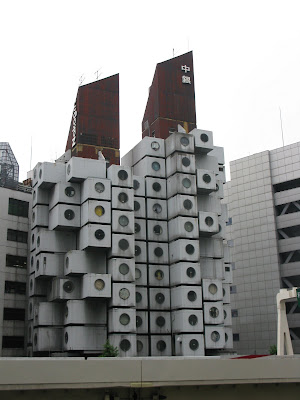
 The next stop on the Yamanote Line is Shinbashi, an area which differs enormously depending on the direction you go on leaving the station.
The next stop on the Yamanote Line is Shinbashi, an area which differs enormously depending on the direction you go on leaving the station. This eatery near the station goes by the name of Baltic Curry, though I'm not sure how close the association is between the Nordic region and the food.
This eatery near the station goes by the name of Baltic Curry, though I'm not sure how close the association is between the Nordic region and the food.  A short walk from the station towards Siodome brings you to the old station building. The original dates back to the early twentieth century, but the building which stands now is a reconstruction and houses a railway museum and a beer hall.
A short walk from the station towards Siodome brings you to the old station building. The original dates back to the early twentieth century, but the building which stands now is a reconstruction and houses a railway museum and a beer hall. This building looks a bit like a game of Jenga left half-done, and is composed of a number of capsule apartments. Once the architecture of the future no doubt, it is now ageing and is apparently scheduled for demolition.
This building looks a bit like a game of Jenga left half-done, and is composed of a number of capsule apartments. Once the architecture of the future no doubt, it is now ageing and is apparently scheduled for demolition. Siodome in general, however, represents a vision of Tokyo's future, with lots of new glass and steel business premises.
Siodome in general, however, represents a vision of Tokyo's future, with lots of new glass and steel business premises.
 Before wandering around among the ultra-modern office buildings I decided to pay a visit to Hama-Rikyu Gardens, traditional Japanese gardens right next to the Tsukiji Fish Market and looking out over the Tokyo Bay area. The gardens make for a pleasant stroll, and it was an enjoyable experience even on this overcast day.
Before wandering around among the ultra-modern office buildings I decided to pay a visit to Hama-Rikyu Gardens, traditional Japanese gardens right next to the Tsukiji Fish Market and looking out over the Tokyo Bay area. The gardens make for a pleasant stroll, and it was an enjoyable experience even on this overcast day.








 Immediately on leaving the gardens and heading back towards Siodome, you are faced with the concrete ugliness of flyovers and main roads which remind you that you're never far from city life in Tokyo.
Immediately on leaving the gardens and heading back towards Siodome, you are faced with the concrete ugliness of flyovers and main roads which remind you that you're never far from city life in Tokyo. The Italian garden on the other side of the main road, however, offers some respite from the concrete jungle.
The Italian garden on the other side of the main road, however, offers some respite from the concrete jungle.
 The Nihon Television building in Siodome is one of the big landmarks in the area and attracts a variety of visitors.
The Nihon Television building in Siodome is one of the big landmarks in the area and attracts a variety of visitors.

 From there, it was a short walk back to the station, which allowed me to venture through to the other side, which is Shinbashi proper.
From there, it was a short walk back to the station, which allowed me to venture through to the other side, which is Shinbashi proper. As with many stations in the area, the passages under the tracks and the arches beneath the railway are packed with izakayas and other eateries.
As with many stations in the area, the passages under the tracks and the arches beneath the railway are packed with izakayas and other eateries.


 An establishment called the Hinomaru, the cultural equivalent of calling a place The Union Jack, The Tricolore or The Stars and Stripes.
An establishment called the Hinomaru, the cultural equivalent of calling a place The Union Jack, The Tricolore or The Stars and Stripes.






No comments:
Post a Comment